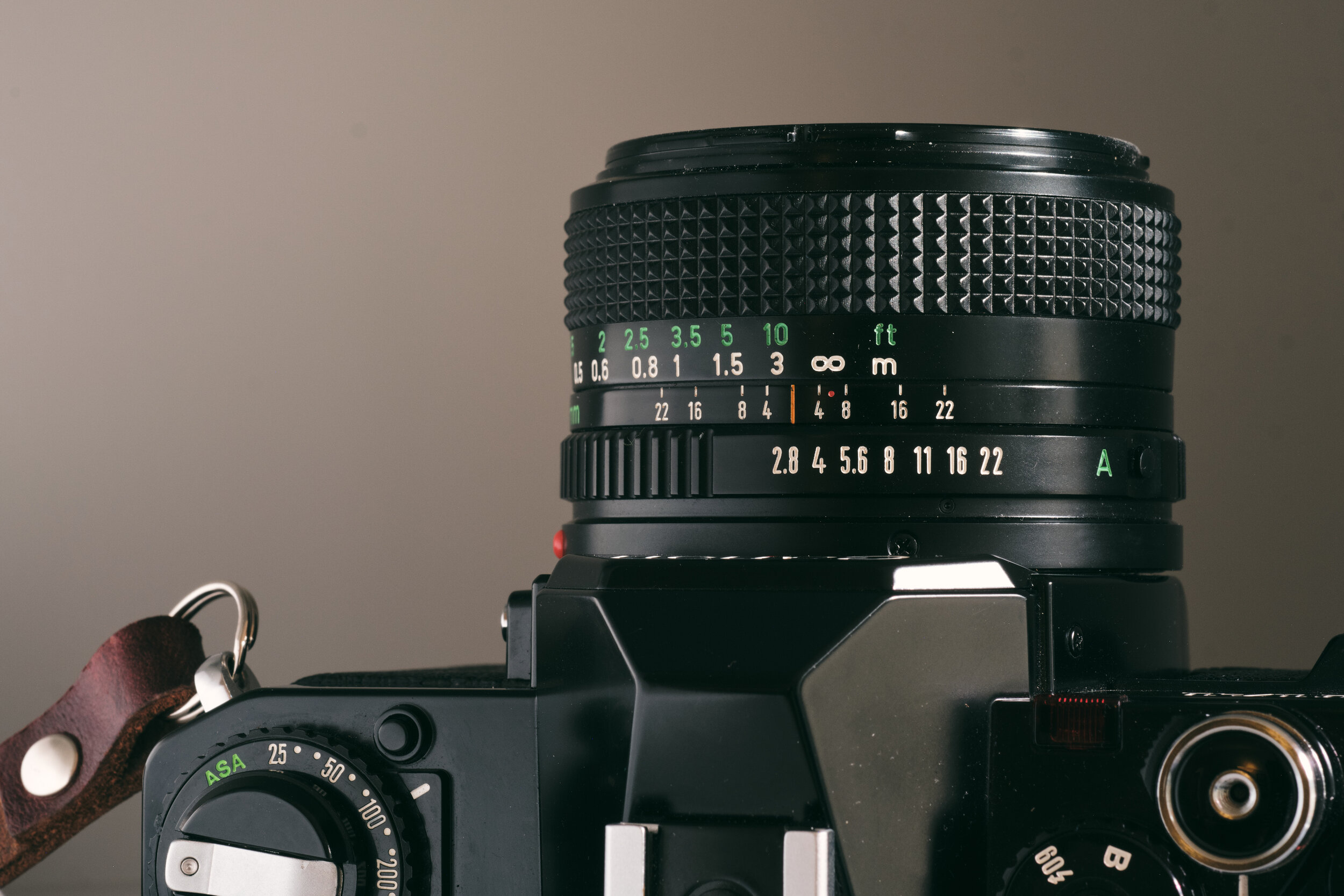Canon FD 28mm f/2.8 Review

The Canon New FD 28mm f/2.8 mounted on a Canon AV-1
A Review of the Canon New FD 28mm f/2.8
My first SLR, ever, was the Canon AV-1, and when I repurchased one last year I got it with a Canon FD 50mm f/1.4. I thought I would test the waters and then see if I wanted other lenses to go with it.
At almost the same time I also picked up a Nikon EM, a camera we used to have back in the eighties also. I also paired this with a 50mm lens. I knew I wanted a 28mm but was unsure if I should get the Nikkor 28mm f/2.8 AIS or the Canon FD 28mm f/2.8.
The Canon New FD 28mm f/2.8 mounted on a Canon AV-1
Canon FD 28mm f/2.8 - Introduction
I owned three Canon FD lenses in the eighties and nineties and notably recall the FD 35mm f/2.8 being sharp and with good color rendition. The two lenses look very similar in price and size but this time I opted for the 28mm as I wanted something noticeably wider than my 50mm.
The FD 28mm f/2.8 dates back to 1979, with a metal mount but otherwise plastic construction. I studied prices on e-Bay and for around $100.00 you can get a mint copy.
They also go for less but the quality looks somewhat questionable on some of the lower-priced options.
Downtown, Vancouver, Canon AV-1, FD 28mm f/2.8 @ f/2.8, Kodak TMAX 100
Canon FD 28mm f/2.8 - Handling and Build Quality
In the end, the price was a factor and I picked the Canon route as the newer model of the Nikkor 28mm f/2.8 AI-S goes for around $260.00 for a decent-looking copy.
The Nikkor looks to be of better build quality but the Canon FD 28mm f/2.8 is not bad at all. The FD 28mm has 7 elements in 7 groups, a minimum focusing distance of 30 cm, and 5 aperture blades.
At 6 oz. / 170 g the FD 28mm is light and compact. The focusing ring is super smooth and the aperture ring feels like other FD lenses, a bit sticky, but it works.
I found a mint copy at my local photo store and paid a bit over average at $120.00 but did not have to worry about overseas shipping. It surprised me they had three FD 28mm lenses to choose from.
Downtown, Vancouver, Canon AV-1, FD 28mm f/2.8 @ f/8, Kodak Ektar 100
The Canon FD 28mm f/2.8 in Action
First of all, I am enjoying the 28mm full-frame look and feel. On my Fujifilm X Series digital setup, I shoot a 21mm and 35mm full-frame equivalent combination and have always realized the gap between 21mm and 35mm is significant and worth exploring more.
When I tested the Fujifilm XF 18mm f/2 R, giving a 28mm equivalent focal length, my conclusion was the same. This focal length is excellent for street photography and a host of general applications. As a side note, I am looking forward to seeing what Fujifilm’s upcoming XF 18mm f/1.4 R LM WR will be like.
The Canon New FD 28mm f/2.8 mounted on a Canon AV-1
There is little, if anything, to complain about from a user’s standpoint when it comes to handling this lens. Being as light as it is, you barely feel it on the camera, and with the nicely dampened and smooth focus ring, getting focus is easy with the viewfinder on the AV-1.
My copy came with a 52mm Canon UV filter but did not have a lens hood.
Downtown, Vancouver, Canon AV-1, FD 28mm f/2.8 @ f/2.8, Kodak TMAX 100
Image Quality
The image quality lives up to expectations and probably even exceeds them. The first couple of rolls, a Kodak TMAX 100, and a Kodak Ektar 100 were both fine-grain films, and the detail is indeed good. Most of my TMAX 100 shots were shot wide open at f/2.8 as the light was fading on a February afternoon.
While there is detectable softness in the corners at f/2.8, I think the lens overall renders a pleasing image and I feel encouraged to use it more.
I also detected some flaring where I normally wouldn’t have seen it. I did not use a lens hood and the winter sun was quite bright. Bokeh is not the best I have ever seen but passable.
Downtown, Vancouver, Canon AV-1, FD 28mm f/2.8 @ f/2.8, Kodak TMAX 100
Canon FD 28mm f/2.8 - Conclusion
It is early in the game but I have already taken a liking to the FD 28mm f/2.8 and especially the 28mm focal length has been neglected by me for too long. I am actually curious to see if the Nikkor version would be even better. It would be wonderful if someone could share in the comments if you have had experience with either lens.
Milano Coffee Shop, Vancouver, Canon AV-1, FD 28mm f/2.8 @ f/8, Kodak Ektar 100
Despite the plastic construction, the FD 28mm f/2.8 does not feel cheap or as if corners have been cut. The compact size makes for a fairly inconspicuous setup with the Canon AV-1.
I can see this accompanying me in the future. Either as a combo with the FD 50mm f/1.4, as a second camera paired with the Nikon EM and 50mm, or on one of my X-Pro cameras with the XF 35mm f/1.4 R.
Update:
I have added new sample images below from a roll of Ilford HP5 black and white negative film
Please see the sample images below. The negatives in this post were copied using a Fujifilm X-Pro2, an AF Micro Nikkor 60mm f/2.8D lens, and Skier Sunray Copybox 3. RAW files were imported to Lightroom and I used the Negative Lab Pro plugin to convert the files.
Canon New FD 28mm f/2.8 - Sample Images
Please click to view larger images.
Soup time, Canon AV-1, Canon FD 28mm f/2.8, Kodak TMAX 100
Downtown, Vancouver, Canon AV-1, Canon FD 28mm f/2.8 @ f/5.6, Kodak TMAX 100
Downtown, Vancouver, Canon AV-1, Canon FD 28mm f/2.8 @ f/4, Kodak TMAX 100
Downtown, Vancouver, Canon AV-1, Canon FD 28mm f/2.8 @ f/2.8, Kodak TMAX 100
Downtown, Vancouver, Canon AV-1, Canon FD 28mm f/2.8 @ f/2.8, Kodak TMAX 100
Downtown, Vancouver, Canon AV-1, Canon FD 28mm f/2.8 @ f/2.8, Kodak TMAX 100
Downtown, Vancouver, Canon AV-1, Canon FD 28mm f/2.8 @ f/2.8, Kodak TMAX 100
Downtown, Vancouver, Canon AV-1, Canon FD 28mm f/2.8 @ f/2.8, Kodak Ektar 100
Downtown, Vancouver, Canon AV-1, Canon FD 28mm f/2.8 @ f/4, Kodak Ektar 100
Downtown, Vancouver, Canon AV-1, Canon FD 28mm f/2.8 @ f/8, Kodak Ektar 100
Downtown, Vancouver, Canon AV-1, Canon FD 28mm f/2.8 @ f/8, Kodak Ektar 100
Downtown, Vancouver, Canon AV-1, Canon FD 28mm f/2.8 @ f/8, Kodak Ektar 100
False Creek, Vancouver, Canon AV-1, Canon FD 28mm f/2.8, Ilford HP5 Plus
False Creek, Vancouver, Canon AV-1, Canon FD 28mm f/2.8, Ilford HP5 Plus
False Creek, Vancouver, Canon AV-1, Canon FD 28mm f/2.8, Ilford HP5 Plus
False Creek, Vancouver, Canon AV-1, Canon FD 28mm f/2.8, Ilford HP5 Plus
False Creek, Vancouver, Canon AV-1, Canon FD 28mm f/2.8, Ilford HP5 Plus
Burrard Bridge, Vancouver, Canon AV-1, Canon FD 28mm f/2.8, Ilford HP5 Plus
Burrard Bridge, Vancouver, Canon AV-1, Canon FD 28mm f/2.8, Ilford HP5 Plus
Burrard Bridge, Vancouver, Canon AV-1, Canon FD 28mm f/2.8, Ilford HP5 Plus
Canon Film SLR and FD Lens Reviews:
Canon AV-1
Canon New FD 28mm f/2.8
Canon New FD 35mm f/2
Canon New FD 50mm f/1.4
Canon New FD 50mm f/1.8
See all of my reviews at a glance: Camera Reviews - Archives
